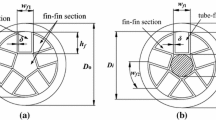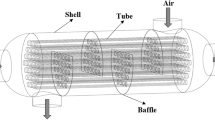Abstract
The heat transfer characteristics of shell-and-tube exhaust gas recirculation (EGR) coolers with different tube bundles were studied by experiment and numerical simulation. The overall heat transfer coefficient and shell-side pressure drop were determined. The influences of tube spacing, baffle form, baffle arrangement and number on the overall heat transfer coefficient and shell-side pressure drop were investigated. The maximum differences between the numerical and experimental results are approximately 4.1% for overall heat transfer coefficient and 3.3% for shell-side pressure drop, respectively. The results indicate that the overall heat transfer coefficient of EGR cooler with wave fin arrays internally finned tubes is 1.3~1.7 times than that of EGR cooler with longitudinal plate-rectangle internally finned tubes. And the comprehensive heat performance is more reasonable when tube spacing and baffle number are equal to 12 mm and 9, respectively. It is confirmed that the trisection ellipse helical baffle is superior to the segmental baffle, but the influence of improving overall thermal performance by setting baffles is limited for small EGR cooler.
















Similar content being viewed by others
Abbreviations
- A :
-
Heat transfer area of all the tubes (m2)
- B S :
-
Segmental baffle spacing (m)
- B T :
-
Helix pitch of TEHB (m)
- C1,C2 :
-
Constants in realizable k-ε model
- d h :
-
Hydraulic diameter of tube (m)
- d i :
-
Inner diameter of tube (m)
- d ins :
-
Inscribed circle diameter of tube (m)
- d o :
-
Outer diameter of tube (m)
- D B :
-
Diameter of tube bundle (m)
- D Ei :
-
Inner diameter of shell side (m)
- f :
-
Friction factor
- G k :
-
Production of turbulent kinetic energy
- h :
-
Heat transfer coefficient (W/(m2·K))
- H M :
-
Arrays height (m)
- k :
-
Turbulent kinetic energy (m2/s2)
- K :
-
Overall heat transfer coefficient (W/(m2·K))
- K 0 :
-
Overall heat transfer coefficient when tube spacing is 11.5 mm without baffles (W/(m2·K))
- L :
-
Length of tube (m)
- L E :
-
Length of shell side (m)
- L f :
-
Length of fin (m)
- L max :
-
Long edge of TEHB (m)
- L M :
-
Arrays length (m)
- M :
-
Mass flow rate (kg/h)
- n :
-
Total number of heat exchange tubes
- N B :
-
Quantity of TEHB
- N f :
-
Wave number
- p :
-
Pressure (Pa)
- P M :
-
Arrays spacing (m)
- Pr:
-
Prandtl number
- Q :
-
Heat transfer rates (W)
- S φ :
-
Generalized source term
- S p :
-
Tube spacing (m)
- S TE :
-
Cross sectional area of crossflow zone for TEHB (m2)
- S S :
-
Cross sectional area of crossflow zone for SB (m2)
- T :
-
Temperature (K)
- u,v,w :
-
Velocity component (m/s)
- U :
-
Velocity vector
- V E :
-
Effective volume (m3)
- V E0 :
-
Effective volume when tube spacing is 11.5 mm without baffle (m3)
- Vs :
-
Shell-side volume flow rate (m3/h)
- W M :
-
Arrays width (m)
- x,y,z :
-
Cartesian coordinates
- α :
-
Tilt angle of TEHB (deg)
- β :
-
Helix angle of TEHB (rad)
- ΔP :
-
Pressure drop (Pa)
- ΔPs0 :
-
Shell-side pressure drop when tube spacing is 11.5 mm without baffles (Pa)
- ΔTm :
-
Logarithmic mean temperature difference (K)
- δ :
-
Thickness of tube wall (m)
- δ f :
-
Thickness of fin (m)
- ε :
-
Dissipation rate of turbulence energy (m3/s2)
- η :
-
fin efficiency
- θ :
-
Wave angle (rad)
- λ :
-
Thermal conductivity (W/(m∙K))
- μ :
-
Dynamic viscosity of fluid (kg/(m·s))
- μ t :
-
Turbulent dynamic viscosity (kg/(m·s))
- ρ :
-
Density (kg/m3)
- σk, σT, σε :
-
Prandtl number for k, T, ε
- Г φ :
-
Generalized diffusion coefficient
- φ :
-
Generalized variable
- ψ :
-
Dimensionless parameter
- ω :
-
Angular velocity (rad/s)
- s:
-
Shell side
- t:
-
Tube side
- w:
-
Wall
References
Fabbri G (1998) Heat transfer optimization in internally finned tubes under laminar flow conditions. Int J Heat Mass Transf 41(10):1243–1253
Li LJ, Cui WZ, Liao Q, Xin Md, Jen TC, Chen QH (2005) Heat transfer augmentation in 3D internally finned and microfinned helical tube. Int J Heat Mass Transf 48:1916–1925
Al-Sarkhi A, Abu-Nada E (2005) Characteristics of forced convection heat transfer in vertical internally finned tube. Int Comm Heat Mass Transfer 32:557–564
Wang QW, Lin M, Zeng M (2009) Effect of lateral fin profiles on turbulent flow and heat transfer performance of internally finned tubes. Appl Therm Eng 29:3006–3013
Muñoz J, Abánades A (2011) Analysis of internal helically finned tubes for parabolic trough design by CFD tools. Appl Energ 88:4139–4149
Rout SK, Thatoi DN, Acharya AK, Mishra DP (2012) CFD supported performance estimation of an internally finned tube heat exchanger under mixed convection flow. Procedia Eng 38:585–597
Wang YG, Zhao QX, Zhou QL, Kang ZJ, Tao WQ (2013) Experimental and numerical studies on actual flue gas condensation heat transfer in a left–right symmetric internally finned tube. Int J Heat Mass Transf 64:10–20
Luo Y, Shao S, Xu HB, Tian CQ, Yang HX (2014) Experimental and theoretical research of a fin-tube type internally-cooled liquid desiccant dehumidifier. Appl Energ 133:127–134
Kim DK (2016) Thermal optimization of internally finned tube with variable fin thickness. Appl Therm Eng 102:1250–1261
Wang YH, Zhang JL, Ma ZX (2017) Experimental determination of single-phase pressure drop and heat transfer in a horizontal internal helically-finned tube. Int J Heat Mass Transf 104:240–246
Qiu QG, Du X, Zhu XJ, Shen SQ (2017) Study on flow and heat transfer in a finned internal cooling duct. Appl Therm Eng 113:58–69
Liu L, Fan YZ, Ling X, Peng H (2013) Flow and heat transfer characteristics of finned tube with internal and external fins in air cooler for waste heat recovery of gas-fired boiler system. Chem Eng Process 74:142–152
Liu L, Ling X, Peng H (2015) Study on turbulent flow and heat transfer performance of tubes with internal fins in EGR cooler. Heat Mass Transf 51:1017–1027
Liu L, Ling X, Peng H (2013) Complex turbulent flow and heat transfer characteristics of tubes with internal longitudinal plate-rectangle fins in EGR cooler. Appl Therm Eng 54:145–152
Bellos E, Tzivanidis C, Tsimpoukis D (2017) Thermal enhancement of parabolic trough collector with internally finned absorbers. Sol Energy 157:514–531
Duan LF, Ling X, Peng H (2018) Flow and heat transfer characteristics of a double-tube structure internal finned tube with blossom shape internal fins. Appl Therm Eng 128:1102–1115
Habibian SH, Abolmaali AM, Afshin H (2018) Numerical investigation of the effects of fin shape, antifreeze and nanoparticles on the performance of compact finned-tube heat exchangers for automobile radiator. Appl Therm Eng 133:248–260
Ko KH, Anand NK (2003) Use of porous baffles to enhance heat transfer in a rectangular channel. Int J Heat Mass Transf 46:4191–4199
Lei YG, He YL, Li R, Gao YF (2008) Effects of baffle inclination angle on flow and heat transfer of a heat exchanger with helical baffles. Chem Eng Process 47:2336–2345
Taher FN, Movassag SZ, Razmi K, Azar RT (2012) Baffle space impact on the performance of helical baffle shell and tube heat exchangers. Appl Therm Eng:143–149
Liu L, Ling X, Peng H (2013) Analysis on flow and heat transfer characteristics of EGR helical baffled cooler with spiral corrugated tubes. Exp Thermal Fluid Sci 44:275–284
Sun H, Qian CF (2013) Study of the heat transfer and flow resistance of large and small hole (LASH) baffle heat exchanger. Appl Therm Eng 54:536–540
Wen J, Yang HZ, Wang SM, Xue YL, Tong X (2015) Experimental investigation on performance comparison for shell-and-tube heat exchangers with different baffles. Int J Heat Mass Transf 84:990–997
Maakoul AE, Laknizi A, Saadeddine S, Metoui ME, Zaite A, Meziane M, Abdellah AB (2016) Numerical comparison of shell-side performance for shell and tube heat exchangers with trefoil-hole, helical and segmental baffles. Appl Therm Eng 109 (175–185
Chen YP, Yang SF, Wu JF, Zhou JH (2017) Impact of helical baffle structure on heat transfer performance of vertical condensers. Appl Therm Eng 115:9–16
Bichkar P, Dandgaval O, Dalvi P, Godase R, Dey T (2018) Study of shell and tube heat exchanger with the effect of types of baffles. Proc Manufact 20:195–200
Aminia R, Aminib M, Jafariniac A, Kashfia M (2018) Numerical investigation on effects of using segmented and helical tube fins on thermal performance and efficiency of a shell and tube heat exchanger. Appl Therm Eng 138:750–760
Shih TH, Liou WW, Shabbrir A, Yang ZG, Zhu J (1995) A new k-ε eddy viscosity model for high Reynolds number turbulent flows. Comput Fluids 24(3):227–238
Yakhot V, Orzag SA (1986) Renormalization group analysis of turbulence: basic theory. J Sci Comput 1:3–11
Kline SJ, McClintock FA (1953) Describing uncertainties in single-sample experiments. Mech Eng 75:3–8
Acknowledgements
This work was supported by the National Natural Science Foundation of China (No. 51606014), Jiangsu Province Natural Science Foundation of China (No. BK20160281) and Jiangsu Province University Natural Science Foundation of China (No. 16KJB470001). On behalf of all authors, the corresponding author states that there is no conflict of interest. 2018 Jiangsu postgraduate research and practical innovation plan (SJCX18_0970).
Author information
Authors and Affiliations
Corresponding authors
Ethics declarations
Conflict of interest
On behalf of all authors, the corresponding author states that there is no conflict of interest.
Additional information
Publisher’s note
Springer Nature remains neutral with regard to jurisdictional claims in published maps and institutional affiliations.
Rights and permissions
About this article
Cite this article
Liu, L., Shen, T., Zhang, L. et al. Experimental and numerical investigation on shell-and-tube exhaust gas recirculation cooler with different tube bundles. Heat Mass Transfer 56, 601–615 (2020). https://doi.org/10.1007/s00231-019-02721-y
Received:
Accepted:
Published:
Issue Date:
DOI: https://doi.org/10.1007/s00231-019-02721-y




